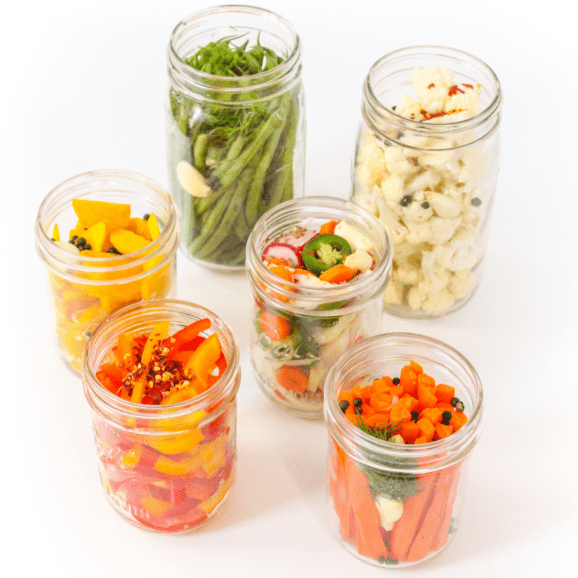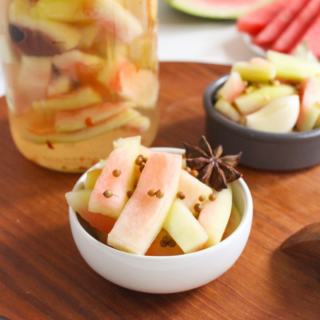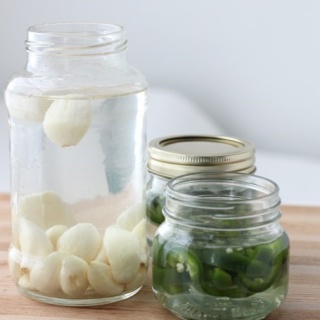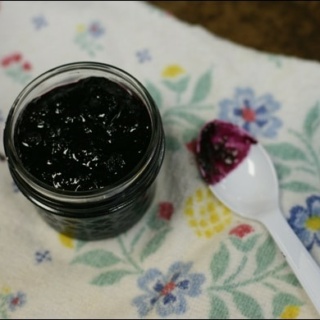Have you ever wondered how lacto-fermentation works? I’ve got you covered! This in-depth guide will walk you through how to ferment vegetables so you can make your own deliciously-flavored veggies at home.
Fermented veggies make a great snack on their own, but they also elevate the flavor of other dishes.
In this post, I’ve included a basic fermented vegetables recipe, plus some additional inspiration with different flavor profiles and veggies – like carrots, string beans, cauliflower, radishes, etc.
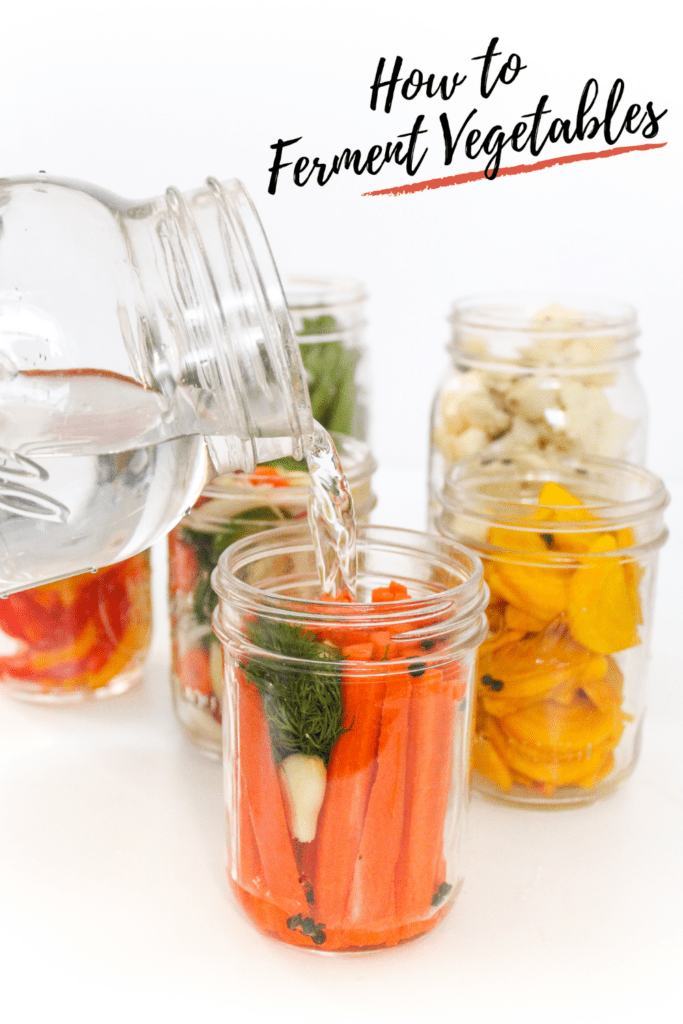
Want to save this post?
Enter your email below and get it sent straight to your inbox. Plus, I'll send you great content every week!
What is lacto-fermentation?
Let’s start with the basics of lacto-fermentation!
All veggies have lactic acid bacteria on (or in) them. Lactic acid bacteria is “good” bacteria (a.k.a. bacteria that helps diversify and support your gut microbiome, rather than making you sick).
Ultimately, the goal with lacto-fermentation is to create an environment where lactic acid bacteria thrives, and harmful bacteria dies.
Thankfully, lactic acid bacteria thrive in salty and acidic environments, whereas other bacteria can’t handle the salt or low pH.
So, with lacto-fermentation, we want to create a balance with brine (salty water) that’s salty enough to kill other bacteria, but not too salty to kill the lactic acid bacteria, too.
That way, lactic acid bacteria will thrive, veggies will ferment, you’ll get a nice “good” bacteria boost (probiotics! <- more on those in that blog post), and you won’t cultivate “bad” bacteria.
Generally, that salty-enough-but-not-too-salty environment comes out to about 5% salt for brined veggies (which are what I focused on for this post).
So, breaking it down into two main steps:
- The veggies go into a salty environment, which weeds out “bad” bacteria that can’t handle salt. Bacteria that naturally occurs on the veggies can start to digest sugars in the veggies, producing an acidic environment and CO2 (hence the slight bubbles you might see).
- The now salty and acidic environment weeds out more “bad” bacteria that can’t handle a low pH. Since lactic acid bacteria thrives in a salty, acidic environment, it takes over and continues to digest sugars and create more acid. That’s why the more time you allow something to ferment, the more acidic and less sweet it will be. (Think about super-funky kombucha vs. sweet kombucha, aged wines, etc. It’s a slightly different organism doing the fermentation, but a similar concept.)
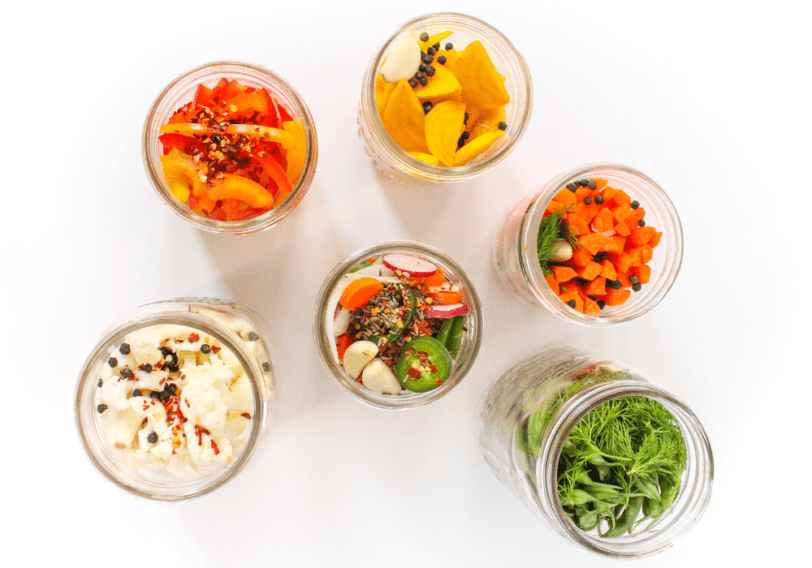
Lacto-Fermentation Methods
When fermenting veggies, you have two options.
The first (the ‘brining method‘) is to make a brine with water and salt and submerge the veggies in it.
The second (the ‘dry-salting method‘) involves salting the veggies and letting the salt bring out all the juices to create a brine, then submerge the veggies in their own salty juices.
The brining method works best for veggies that don’t give off a lot of moisture, like sliced carrots and radishes, cauliflower, green beans, cucumber spears, etc.
The dry salting method works best for super watery veggies, like cabbage, or shredded carrots/radishes/cucumbers, etc.
Shredding the veggies like carrots, radishes, and cucumbers gives them a lot more surface area to let out juices, hence the dry salting method is best for those. But when you just use carrot sticks or cucumber spears, they don’t tend to let out as much liquid, so brining works best.
It’s certainly not a hard-and-fast rule, and fermentation is meant to be fairly flexible. On that note – sliced peppers and onions will usually work well with either method.
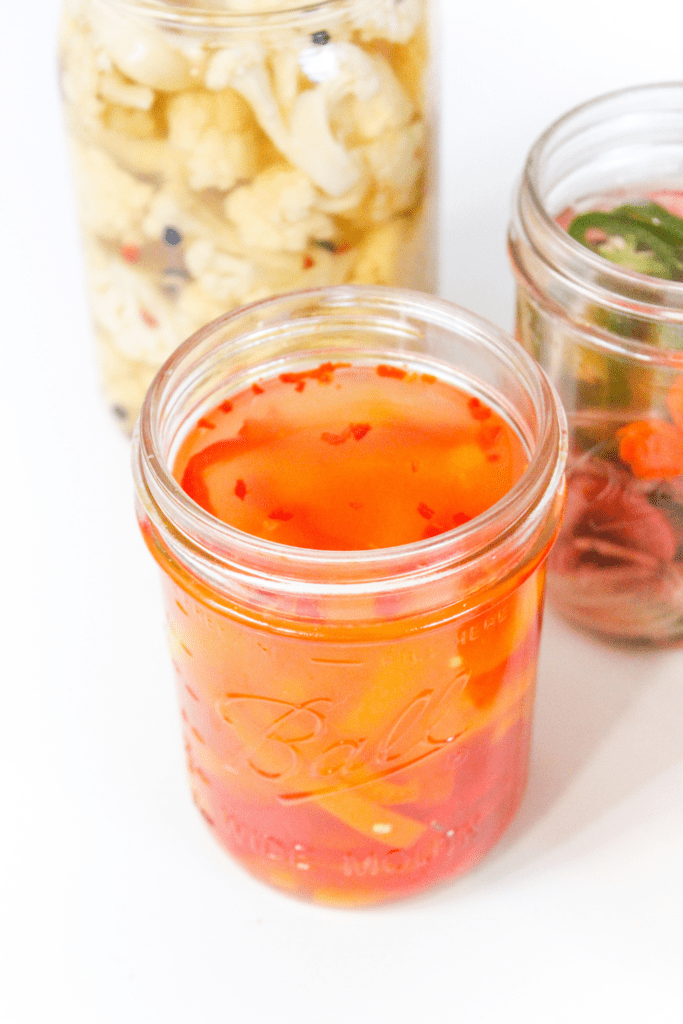
Mason Jar Fermentation: How it Works
As far as the actual lacto-fermentation “recipe” goes, it couldn’t be simpler. Basically, you submerge veggies in salt water and wait.
There are 3 factors that affect lactic acid fermentation that you can play around with if things don’t go perfectly. (But I promise, in general it’s really not that hard or finicky!)
- Amount of salt
- Temperature
- Time fermenting
As a general rule, bacteria reproduces faster in warmer environments, so the amount of time you need to ferment something might be shorter in the summer versus the winter.
If you are fermenting something and it gets moldy, you might need to adjust by slightly increasing salt to kill off mold spores at the beginning. Or, ferment slower in a slightly cooler environment. Make sure your jars and lids are totally clean, too!
It’s all a fun game of trial and error, but the recipe inspiration I’ve included below should typically work for all seasons.
Fermented Vegetable Recipe Ingredients & Steps
Here are the general ingredients you’ll need (see the recipe card at the end of the post for the full details/measurements):
- Veggies (green beans, carrot sticks, broccoli or cauliflower florets, sliced peppers, sliced beets, etc.)
- Salt (kosher salt or sea salt)
- Seasonings of choice (red pepper flakes, cumin seeds, peppercorns, whole garlic cloves, herb sprigs, etc)
- Equipment: clean glass jars
- Optional: fermentation weights/springs, valved or airlock lids
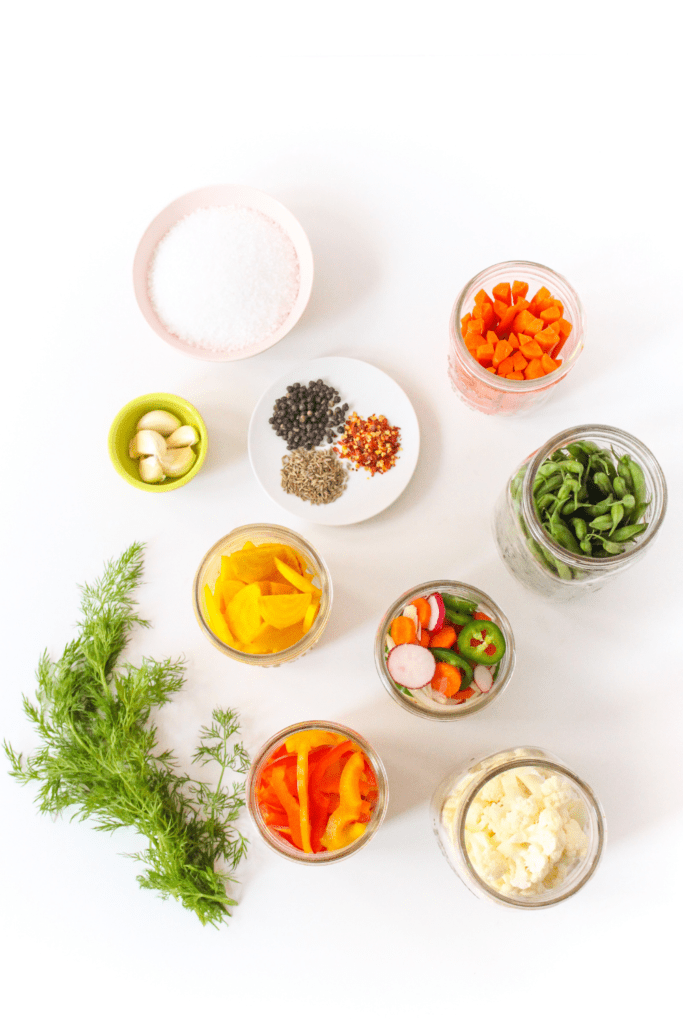
Be sure to leave at least 1 inch of space on top of the veggies. (Rule of thumb: it’s usually better to use too large of a container vs. too small!)
Next, use a kitchen scale (if possible) to measure out 5 grams of salt to every 100 grams of water that you’re using. (This is the base for your 5% salt brine).
I recommend weighing the salt and water rather than using volume, because salt weight:volume ratios vary drastically between different types of salts.
But if you don’t have a scale and still want to ferment, using approximates should usually work. In general, 1 teaspoon of kosher salt is about 5 grams and 1 teaspoon of fine sea salt is about 6 grams.
Mix together salt with room-temperature water, stirring vigorously, until salt is dissolved.
Then, pour the brine over the veggies until they’re submerged. Leave about 1/2 inch space in the jar above the brine. If necessary, use a weight or spring to weigh the veggies down so they stay fully submerged (links to some products to try are below in the “equipment” section).
Use a valved or airlock lid to cover. This allows built-up gas to escape without letting excess air or bugs inside the jar.
If using a regular lid, don’t screw it on completely tight (and be sure to open the jar once a day to release built-up gas).
Keep jars at room temperature for 3-6 days.
At the 3-day mark, taste the veggies to see if they’ve reached the acidity level/pickled taste that you like. If they’re salty but without any tang, let sit another day and test again each subsequent day until they’re to your liking.
Once they are fermented to your liking, enjoy, and store them in the fridge for up to 3 months.
Pickling vs. Lacto-Fermenting
The main difference between pickling and fermenting is the presence of probiotics (“good” bacteria) with fermentation.
Fermentation uses natural bacteria from the vegetables to achieve the desired flavor, whereas pickling uses an acidic substance (often vinegar) instead. With fermenting, you get that flavor from a natural chemical reaction.
Lacto-Fermentation Equipment
If you’re planning on fermenting with any frequency, I would recommend investing in the weights/springs/valved or airlock lids.
They just make the whole process easier, and they’re not too pricey as far as kitchen equipment goes.
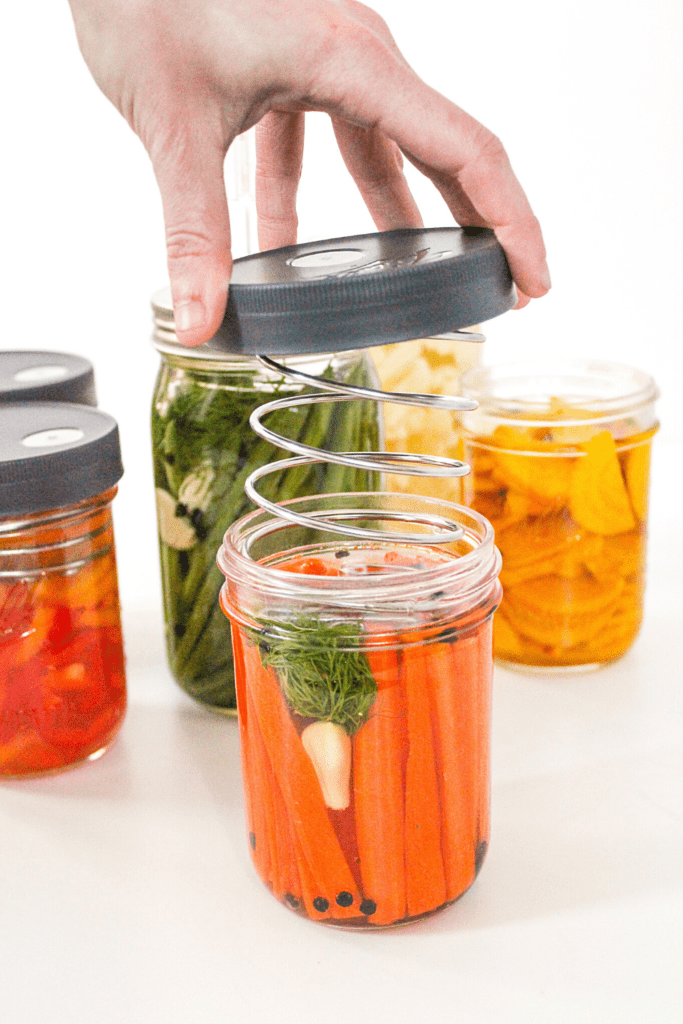
The top two fears most people have around fermenting are growing mold and having jars explode.
These items help to eliminate those accidents by releasing pressure without letting additional oxygen in and keeping veggies fully submerged.
Here are affiliate links to the tools I’d recommend: airlock lids, weights, springs & valve lids.
The Best Veggies to Ferment (+ Recipe Ideas)
And now, here’s some recipe inspiration for different veggies and flavor-enhancing herbs/spices!
- carrot sticks + 1 clove garlic + pinch of black peppercorns + 1 sprig fresh dill
- cauliflower + 2 cloves garlic + pinch of red pepper flakes + pinch of black peppercorns
- green beans + 2 sprigs fresh dill + 2 cloves garlic + pinch of black peppercorns
- sliced radish, jalapeno, onion, and carrots + pinch of cumin seeds + pinch of red pepper flakes + 1 clove garlic
- sliced peeled beets + 1 clove garlic + pinch of black peppercorns
- watermelon rind is awesome for fermenting – like cucumber, but less prone to getting mushy. Try this recipe: Fermented Watermelon Rind
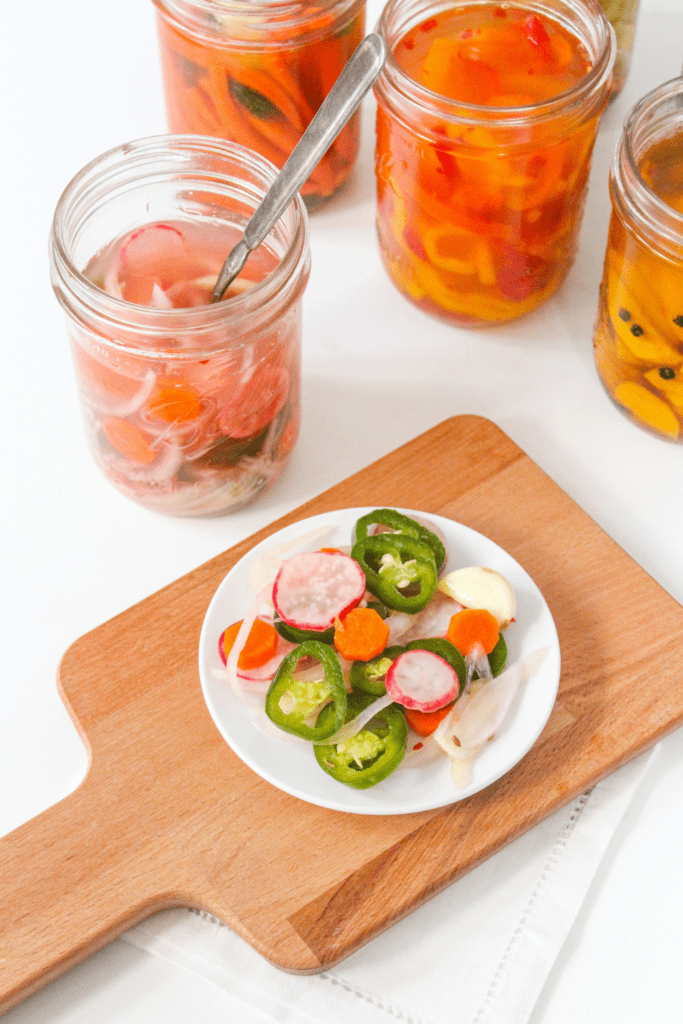
I hope you found this helpful – now it’s time to get fermenting! 🙂
You’ll find the full vegetable lacto-fermentation recipe (plus more notes on troubleshooting, etc.) at the bottom of this post. Enjoy!
Looking for more posts on related topics and/or preparing fruits and vegetables? Check these out:
- Fermented Watermelon Rind
- Health Benefits of Fermented Foods (a guest post from a fellow RD a few years ago)
- What are Prebiotics and Probiotics?
- Pickled Watermelon Rind (Two Ways)
- How to Peel a Pomegranate (+ Seed It)
- How to Roast Frozen Vegetables (+ Recipe Ideas!)
- The Best Frozen Vegetables to Buy
- How to Love Veggies
- How to Can Your Own Food at Home (this post is from back when I doing my nutrition internship at a local public health organization – my co-intern and I taught a class on canning!)
Have you tried fermenting before, or do you plan to? Let me know in the comments!
Lacto-Fermentation: How to Ferment Veggies in a Brine
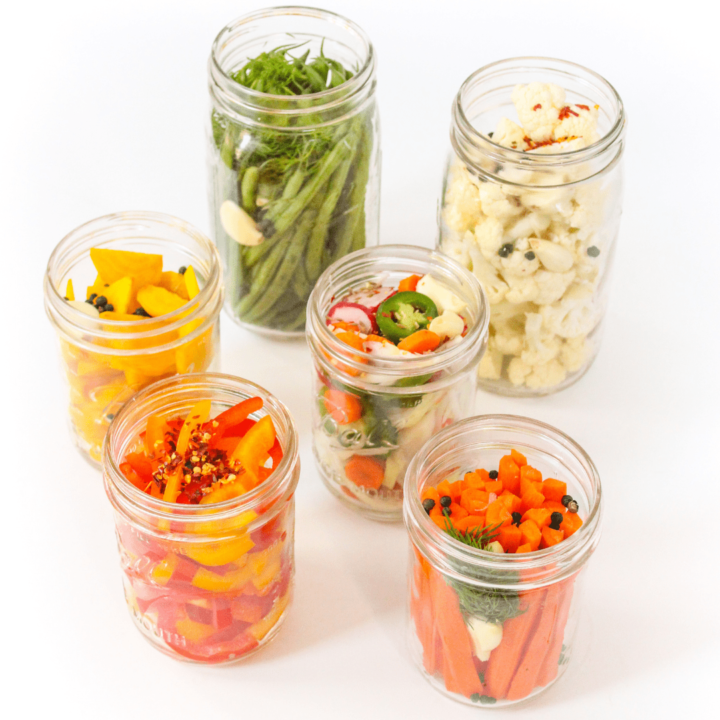
This lacto-fermentation base recipe + flavor inspiration is perfect for making your own deliciously-flavored fermented vegetables at home!
Ingredients:
- Veggies (green beans, carrot sticks, broccoli or cauliflower florets, sliced peppers, sliced beets, etc.)
- Salt (kosher salt or sea salt)
- Room-temperature water
- Seasonings (red pepper flakes, cumin seeds, peppercorns, whole garlic cloves, herb sprigs, etc.)
Equipment
- clean glass jars
- optional: fermentation weights/springs, valved or airlock lids
Flavor Combinations
- - Carrot sticks + 1 clove garlic + pinch of black peppercorns + 1 sprig fresh dill
- - Cauliflower + 2 cloves garlic + pinch of red pepper flakes + pinch of black peppercorns
- - Green beans + 2 sprigs fresh dill + 2 cloves garlic + pinch of black peppercorns
- - Sliced radish, jalapeno, onion, and carrots + pinch of cumin seeds + pinch of red pepper flakes + 1 clove garlic
- - Sliced peeled beets + 1 clove garlic + pinch of black peppercorns
Instructions:
- Place veggies and seasonings in jars, leaving at least 1 inch of room on top of the veggies. It's always safer to use too big of a container than too small.
- Combine salt with room-temperature water (5 grams of salt to every 100 grams of water) to make a 5% salt brine. Be sure to create enough to submerge all the vegetables you are fermenting. Stir vigorously to dissolve salt. (I recommend using a scale so you can be exact).
- Pour the brine on top of the veggies, until they are completely submerged. Leave at least 1/2 inch of space above the top of the brine. If needed, weigh the veggies down with a weight or spring to make sure they stay submerged.
- Cover with a valved or airlock lid to allow built-up gas to escape without letting bugs/excess air inside. Or cover with a regular jar lid, but don't screw completely tight. If using a regular jar lid, you'll want to open the jar once a day to release any built up gas.
- Let veggies sit at room temperature for 3-6 days. After 3 days, taste the veggies to see if they're as acidic/pickled as you'd like. If they just taste salty without any tang, let sit for another day and keep tasting daily until they reach your desired sourness.


